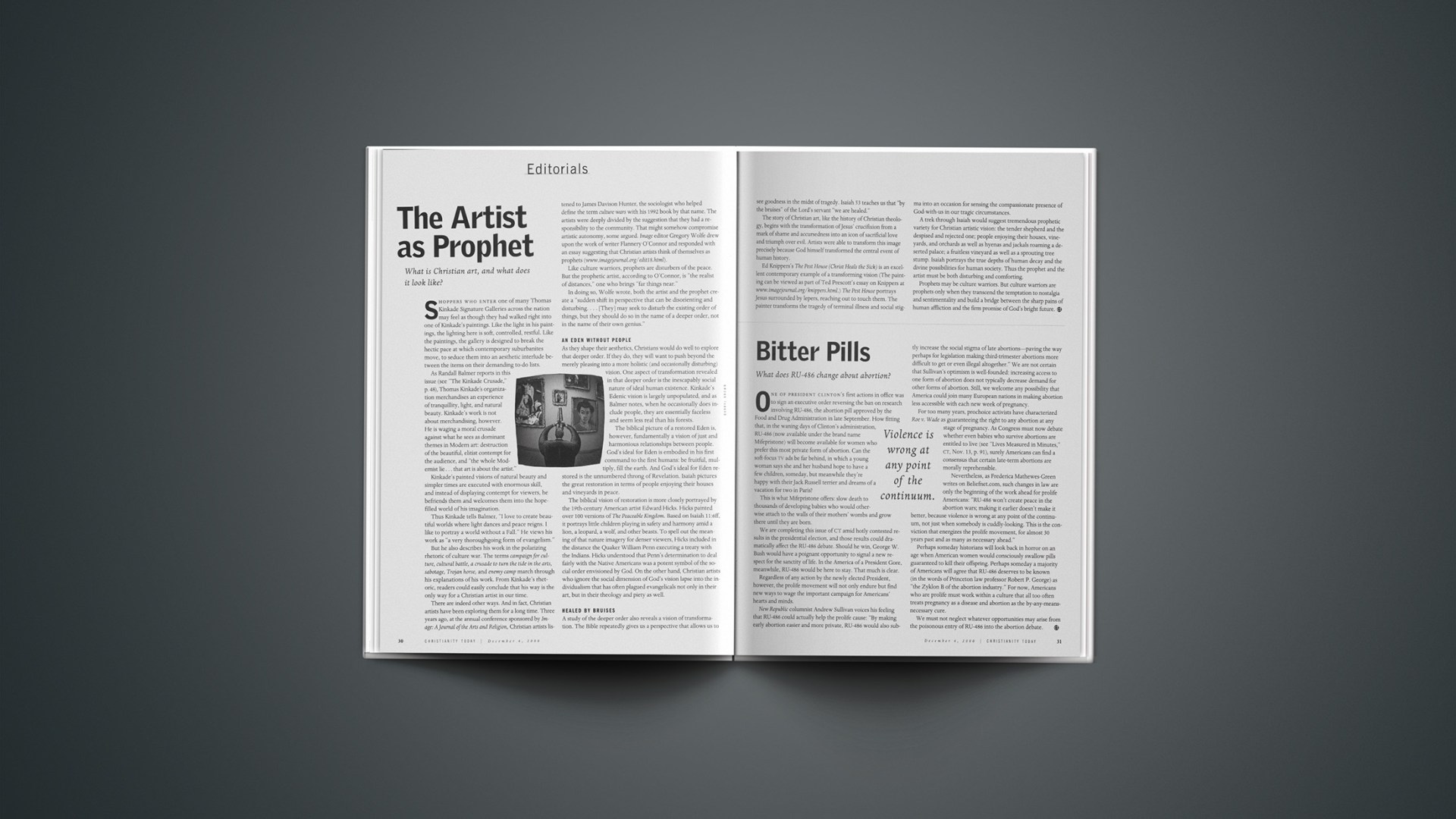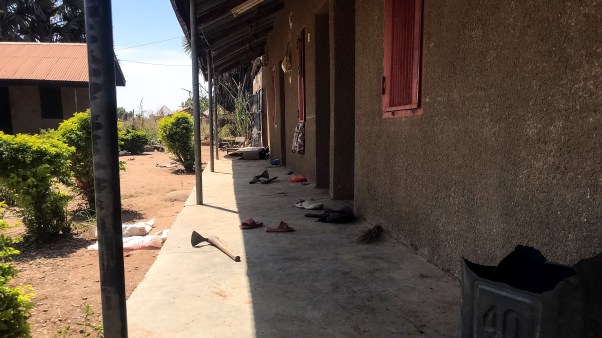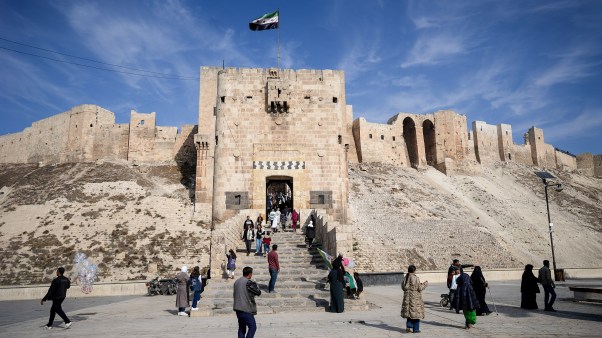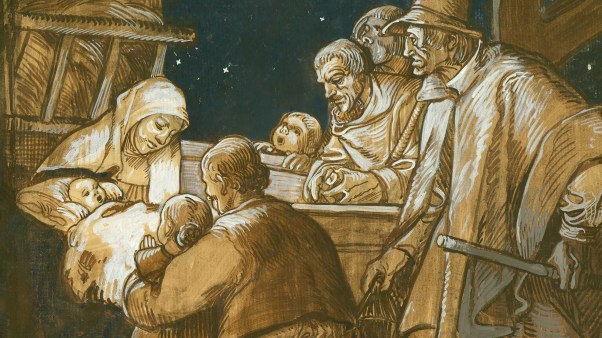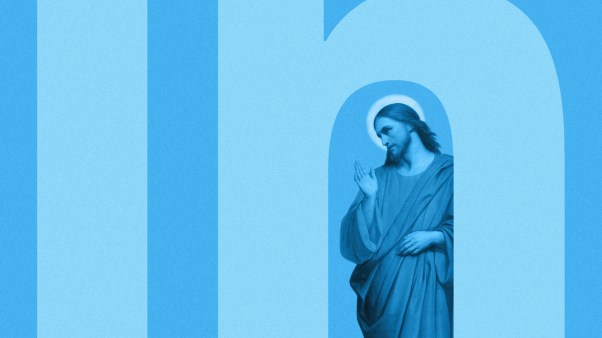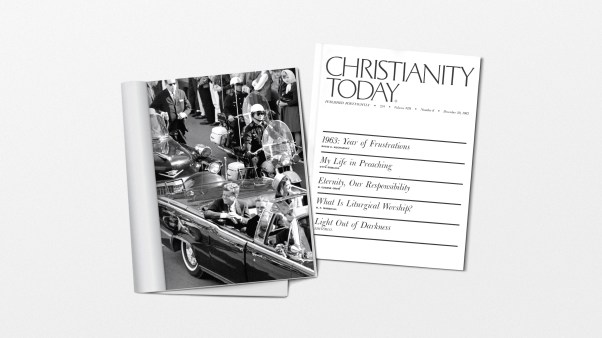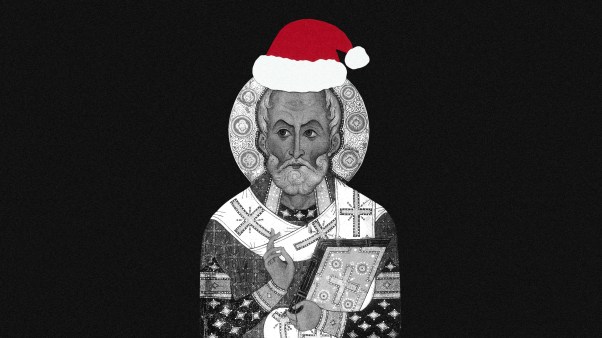Shoppers who enter one of many Thomas Kinkade Signature Galleries across the nation may feel as though they had walked right into one of Kinkade’s paintings. Like the light in his paintings, the lighting here is soft, controlled, restful. Like the paintings, the gallery is designed to break the hectic pace at which contemporary suburbanites move, to seduce them into an aesthetic interlude between the items on their demanding to-do lists.
As Randall Balmer reports in this issue (see “The Kinkade Crusade,” p. 48), Thomas Kinkade’s organization merchandises an experience of tranquillity, light, and natural beauty. Kinkade’s work is not about merchandising, however. He is waging a moral crusade against what he sees as dominant themes in Modern art: destruction of the beautiful, elitist contempt for the audience, and “the whole Modernist lie … that art is about the artist.”
Kinkade’s painted visions of natural beauty and simpler times are executed with enormous skill, and instead of displaying contempt for viewers, he befriends them and welcomes them into the hope-filled world of his imagination.
Thus Kinkade tells Balmer, “I love to create beautiful worlds where light dances and peace reigns. I like to portray a world without a Fall.” He views his work as “a very thoroughgoing form of evangelism.”
But he also describes his work in the polarizing rhetoric of culture war. The terms campaign for culture, cultural battle, a crusade to turn the tide in the arts, sabotage, Trojan horse, and enemy camp march through his explanations of his work. From Kinkade’s rhetoric, readers could easily conclude that his way is the only way for a Christian artist in our time.
There are indeed other ways. And in fact, Christian artists have been exploring them for a long time. Three years ago, at the annual conference sponsored by Image: A Journal of the Arts and Religion, Christian artists listened to James Davison Hunter, the sociologist who helped de fine the term culture wars with his 1992 book by that name. The artists were deeply divided by the suggestion that they had a responsibility to the community. That might somehow compromise artistic autonomy, some argued. Image editor Gregory Wolfe drew upon the work of writer Flannery O’Connor and responded with an essay suggesting that Christian artists think of themselves as prophets.
Like culture warriors, prophets are disturbers of the peace. But the prophetic artist, according to O’Connor, is “the realist of distances,” one who brings “far things near.”
In doing so, Wolfe wrote, both the artist and the prophet create a “sudden shift in perspective that can be disorienting and disturbing. … [They] may seek to disturb the existing order of things, but they should do so in the name of a deeper order, not in the name of their own genius.”
An Eden without people
As they shape their aesthetics, Christians would do well to explore that deeper order. If they do, they will want to push beyond the merely pleasing into a more holistic (and occasionally disturbing) vision. One aspect of transformation revealed in that deeper order is the inescapably social nature of ideal human existence. Kinkade’s Edenic vision is largely unpopulated, and as Balmer notes, when he occasionally does include people, they are essentially faceless and seem less real than his forests.
The biblical picture of a restored Eden is, however, fundamentally a vision of just and harmonious relationships between people. God’s ideal for Eden is embodied in his first command to the first humans: be fruitful, multiply, fill the earth. And God’s ideal for Eden restored is the unnumbered throng of Revelation. Isaiah pictures the great restoration in terms of people enjoying their houses and vineyards in peace.
The biblical vision of restoration is more closely portrayed by the 19th-century American artist Edward Hicks. Hicks painted over 100 versions of The Peaceable Kingdom. Based on Isaiah 11:6ff, it portrays little children playing in safety and harmony amid a lion, a leopard, a wolf, and other beasts. To spell out the meaning of that nature imagery for denser viewers, Hicks included in the distance the Quaker William Penn executing a treaty with the Indians. Hicks understood that Penn’s determination to deal fairly with the Native Americans was a potent symbol of the social order envisioned by God. On the other hand, Christian artists who ignore the social dimension of God’s vision lapse into the individualism that has often plagued evangelicals not only in their art, but in their theology and piety as well.
Healed by bruises
A study of the deeper order also reveals a vision of transformation. The Bible repeatedly gives us a perspective that allows us to see goodness in the midst of tragedy. Isaiah 53 teaches us that “by the bruises” of the Lord’s servant “we are healed.”
The story of Christian art, like the history of Christian theology, begins with the transformation of Jesus’ crucifixion from a mark of shame and accursedness into an icon of sacrificial love and triumph over evil. Artists were able to transform this image precisely because God himself transformed the central event of human history.
Ed Knippers’s The Pest House (Christ Heals the Sick) is an excellent contemporary example of a transforming vision. The Pest House portrays Jesus surrounded by lepers, reaching out to touch them. The painter transforms the tragedy of terminal illness and social stigma into an occasion for sensing the compassionate presence of God-with-us in our tragic circumstances.
A trek through Isaiah would suggest tremendous prophetic variety for Christian artistic vision: the tender shepherd and the despised and rejected one; people enjoying their houses, vineyards, and orchards as well as hyenas and jackals roaming a deserted palace; a fruitless vineyard as well as a sprouting tree stump. Isaiah portrays the true depths of human decay and the divine possibilities for human society. Thus the prophet and the artist must be both disturbing and comforting.
Prophets may be culture warriors. But culture warriors are prophets only when they transcend the temptation to nostalgia and sentimentality and build a bridge between the sharp pains of human affliction and the firm promise of God’s bright future.
Related Elsewhere
Read Christianity Today‘s related article, “The Kinkade Crusade | ‘America’s most collected artist‘ is a Christian who seeks to sabotage Modernism by painting beauty, sentiment, and the memory of Eden.”
Read Gregory Wolfe’s Image editorial “The Artist as Prophet.”
View Edward Hick’s The Peaceable Kingdom.
View Knipper’s The Pest House.
Other articles about the role of Christian artists and art include ArtsReformation.com’s Paul Erlandson’s “Mystery, Manners, and the Mind of the Maker” and The Crossing‘s interview with Charlie Peacock.
Want to see something interesting? Compare Thomas Kinkade’s “Sunrise” (from ThomasKinkade.com) to Caspar David Friedrich’s “Morning in the Riesengebirge,” painted in 1810.
Copyright © 2000 Christianity Today. Click for reprint information.

